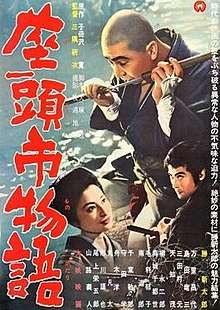The Tale of Zatoichi
The Tale of Zatoichi (Japanese: 座頭市物語 Zatōichi monogatari), directed by Kenji Misumi, is the first film of a classic Japanese samurai drama saga starring Shintaro Katsu as Zatoichi, a character created by Kan Shimozawa.
| The Tale of Zatoichi | |
|---|---|
 | |
| Directed by | Kenji Misumi |
| Screenplay by | Minoru Inuzuka |
| Based on | The Tale of Zatoichi by Kan Shimozawa |
| Starring |
|
| Music by | Akira Ifukube |
| Cinematography | Chishi Makiura |
| Edited by | Kanji Suganuma |
Production company | |
| Distributed by | Dalei Studios |
Release date |
|
Running time | 95 minutes |
| Country | Japan |
| Language | Japanese |
Plot
The blind masseur Zatoichi is hired by yakuza gang-leader Sukegoro (Eijiro Yanagi) as he thinks that war is inevitable with the rival yakuza Shigezo (Ryuzo Shimada). Zatoichi has a distinguished reputation as a swordsman and Sukegoro thinks he is money well spent. Shigezo responds by hiring a ronin of similar repute, Miki Hirate (Shigeru Amachi). Ichi is a meek and humble man who is commonly underestimated by most men, and looked upon suspiciously. His being a masseur, which was a position of low regard in feudal Japan, merely increases the hostility that is shown towards him. They even try to take advantage of his blindness in a gambling den, but from early on it is clear that Zatoichi draws strength from his disability.
The only person who respects him is Hirate, who has a similar code of practice. Though Hirate and Ichi know they must fight when the war begins, they develop a kind of friendship. Hirate is eager to fight Zatoichi, as he is terminally ill with tuberculosis and considers death at the hands of a master swordsman preferable. As Hirate becomes increasingly sick, Sukegoro decides to attack Shigezo. He also tells Ichi that he is no longer needed. However, as the war begins, Shigezo informs Hirate of his fallback plan since Hirate is ill, that he intends to shoot Ichi with his rifle. Hirate drags himself from his bed to fight Zatoichi on the condition that the rifle is left behind. Ichi learns from a boy at the temple where Hirate was staying that Hirate will be fighting after all, and also learns the reason. Zatoichi travels to the battle to duel with the dying samurai. After the tense final fight, in which Zatoichi prevails, Zatoichi leaves Iioka and rejects the advances of Otane (Masayo Banri), who has become disillusioned with the yakuza lifestyle, to continue as a solitary wanderer.
Cast
- Shintaro Katsu as Zatoichi
- Masayo Banri as Otane
- Ryūzō Shimada as Shigezō of the Sasagawa Yakuza
- Hajime Mitamura as Hanji of Matsugishi
- Shigeru Amachi as Miki Hirate
- Chitose Maki as Hanji's wife Yoshi
- Ikuko Mōri as Shigezō's wife Oyutaka
- Michio Minami as Tatekichi of the Iioka Yakuza
- Eijirō Yanagi as Sukegorō of Iioka
- Toshio Chiba as Masakichi of Iioka
- Manabu Morita as Seisuke of Iioka
- Yoichi Funaki as Yogorō of Sasagawa
- Kin'ya Ichikawa as Mokichi of Sasagawa
- Eigorō Onoe as Rihei of Sasagawa
- Yoshito Yamaji as Tatekichi's father Yahei
- Yukio Horikita as Kanaji of Sasagawa
- Ryūji Fukui as Daihachi of Iioka
Release
The Tale of Zatoichi was released in Japan on April 12, 1962.[1][2] It was re-issued theatrically in 1976.[2] The film was followed-up with The Tale of Zatoichi Continues in 1962.[2]
Reception
The film received positive reviews earning 100% from review aggregator Rotten Tomatoes according to 7 reviews. The film summoned the most sequels of a samurai film and has also spawned a remake in 2003.[3]
References
Footnotes
- Galbraith IV 1996, p. 262.
- Galbraith IV 1996, p. 263.
- The Tale of Zatoichi at Rotten Tomatoes
Sources
- Galbraith IV, Stuart (1996). The Japanese Filmography: 1900 through 1994. McFarland. ISBN 0-7864-0032-3.CS1 maint: ref=harv (link)